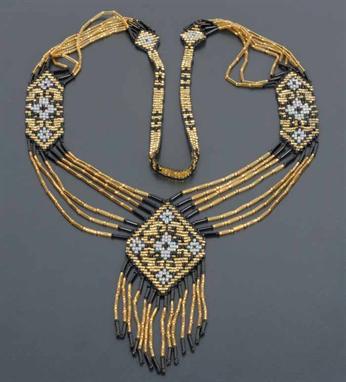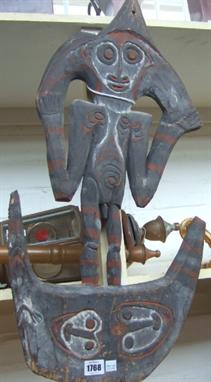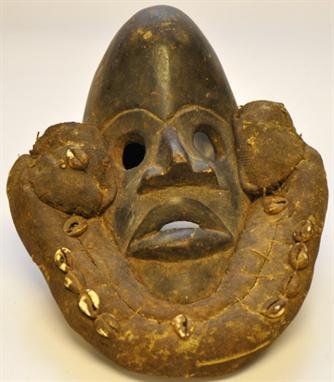We found 6698 price guide item(s) matching your search
There are 6698 lots that match your search criteria. Subscribe now to get instant access to the full price guide service.
Click here to subscribe- List
- Grid
Literature. A collection of books relating to Tribal and Oceanic Art, including: Schmitz, Carl. A., Oceanic Art; Christensen, Erwin. O., Primitive Art; Brake, McNeish and Simons, Art of the Pacific; Elisofon, Eliot, The Sculpture of Africa; Vogel, Susan, African Art from the Tishman Collection and various others. (21)
* A carved wooden ancestor figure, Chambri Lakes, Sepik River, Papua New Guinea, mid-20th c., wooden black-painted figure of male form, with red and white-painted detail, shell eyes, pierced ears tied with twisted twine, and twine loin cloth threaded with a shell, 675 x 90mm (26.5 x 3.5ins). Ancestor figures were made to represent both individual family ancestors and tribal ancestors, as well as clan or tribal totemic animals and other bush spirits. Traditionally they were cared for by family elders who kept the figures in shrines and made frequent offerings to them for the well-being of the family. The figure’s powers could be heightened by being anointed with magical medicines and they were used in a number of ways: to protect the sick from evil forces, guard villages from unwelcome intruders and to ascertain the guilt, or otherwise, of a defendant. It was believed that they could enhance life by interceding on a high plane to provide food, prevent and cure illness, acquire stature, and counter sorcery. This ancestor figure is from the collection of the controversial and eccentric artist Robert Lenkiewicz (1941-2002). The artist would have been particularly interested in the connection between tribal art and the occult. At the time of his death Lenkiewicz’s libray contained some 25,000 volumes devoted to art, the occult sciences, demonolatry, philosophy, metaphysics, alchemy, death, psychology and sexuality, preoccupations which surface in many of his paintings, and his collection of books on magic and witchcraft was one of the finest in private hands. (1)
Elisofon/Fagg. The Sculpture of Africa,1978 New York, 1978 § Christensen (Erwin O.) Primitive Art, New York, 1955 § Newton (D.) and Lee Boltin. The Nelson A.Rockefeller Collection: Masterpieces of Primitive Art, New York, 1978 § Lamb (V.) and Judy Holmes. Nigerian Weaving, 2006, illustrations, many colour, original cloth or cloth-backed boards, dust-jackets, the first two a little rubbed and frayed at edges; and a small quantity of others on African and tribal art, mostly catalogues, folio & 4to (1 Box)
A Benin bronze leopard, Nigeria, probably 19th century, in standing position with outscrolling tail, the body entirely covered with concentric spots, dark green and copper patination, 34cm wide, 22.5cm high, 7cm deep, Note: Almost all Benin art was created to honor the king, or Oba, whose ancestral family has reigned since the 15th century. Benin bronzes were brought to Europe following a punitive expedition by the British in 1897, and caused a great sensation. Bronze Leopards were often used as royal water vessels - the water was poured from the mouth over the Oba`s hands in cleansing rituals. They were kept on royal altars. Like an ideal tribal leader, the leopard is revered for harmonizing the attributes of menace and temperance. The leopard also stands above life because like a leader, he has bestowed upon him the privilege of the `right to kill`.

































